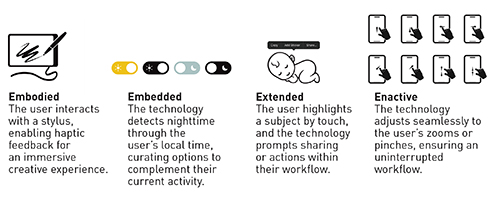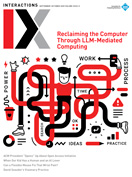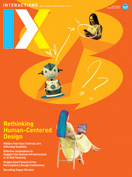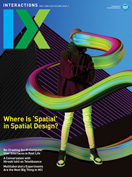Authors: Roxanne N. Rashedi
Posted: Mon, February 10, 2025 - 12:44:00
Embodied cognition—the idea that our cognitive processes are deeply influenced by our bodily experiences—has been a consistent theme throughout my research [1]. This framework has shaped my work in early childhood education, mindful movement like yoga, and gaming with youth on the autism spectrum [2,3,4]. Now, as a user experience researcher, I continue to explore how embodied cognition informs user interaction and creativity.
The Importance of Embodied Cognition in UX Research
An embodied cognitive perspective suggests that user interactions with technology are deeply connected to physical actions, such as gestures, hand movements, and sensory feedback. By applying Evan Thompson’s 4E cognition model—embodied, embedded, enactive and extended—we can explore how generative artificial intelligence (GenAI) engages users across multiple dimensions [5]. Figure 1 illustrates examples of the adapted 4E model.

Figure 1. Examples of the adapted 4E model.
For instance, GenAI that allows users to quickly create complex images is undoubtedly powerful, yet users still desire a sense of agency and a tangible feeling that they have contributed to the creative process. While most UX research has traditionally focused on cognitive ease, integrating both cognitive and physical dimensions can foster a holistic understanding of the UX. This approach allows GenAI to extend users’ creative abilities without disrupting the natural flow of interaction.
Consider how users physically interact with GenAI when creating assets. How does GenAI respond to users’ natural movements? By examining how GenAI features respond to users’ gestures and actions, such as pinching to zoom, swiping to rotate, or even adjusting hand pressure on a stylus, we can understand if the technology feels like a seamless extension of their bodies, enhancing the user’s capabilities, or if it introduces friction, making the experience feel disconnected. Observing users’ navigations and physical cues, such as relaxed postures or repeated gestures, can reveal whether they feel empowered or constrained by the technology. For professionals, aligning GenAI with natural actions is crucial to achieve a seamless, fluid experience, fostering a state of “flow” where they are fully immersed and engaged [6]. This state is invaluable in creative workflows, inviting users to tap into their skills and intuition while fostering a dynamic relationship between mind, body, and technology.
Adopting an embodied cognitive framework also enhances inclusivity and accessibility in design, as it aligns the technology with users’ natural movements and sensory experiences. For embodied cognition, integrating haptic feedback in stylus-based tools can guide users with visual challenges, giving tactile cues to navigate interfaces. Similarly, for embedded cognition, adapting to the user’s physical environment and prioritizing visual cues or vibrations to confirm actions in noisy environments can reduce reliance on sound and aid those with sensory sensitivities. For enactive cognition, enabling pinching gestures to zoom in and out on an image can help users adjust focus or scale with ease. For extended cognition, leveraging voice controls to enhance accessibility, such as “increase brightness,” can expand users’ control, particularly for those using screen readers.
While direct research linking embodied cognition to accessibility is limited, studies indicate that incorporating sensory feedback, such as haptics and auditory cues, can reduce cognitive load, ultimately making technology more accessible to a wider range of users [7]. As I discussed earlier, multimodal interaction strategies (e.g., gesture-based controls for manipulating GenAI models for image adjustments) can benefit users with sensory or motor challenges by providing fluid control over the technology. Moreover, incorporating touch gestures or voice commands into interfaces may allow users to make precise adjustments, like modifying brushstrokes or selecting items, without relying on traditional keyboard and mouse controls. These examples, though not comprehensive, illustrate how embodied interaction methods can empower users with limited dexterity or alternative communication preferences to engage in creative tasks. Integrating these strategies enables UX design to support diverse user abilities, enhancing accessibility, precision, and creativity in interactions with GenAI.
The Future of Embodied Cognition in the Era of GenAI
GenAI has the potential to amplify human abilities, but this can only happen if it integrates smoothly into the physical and cognitive processes that underpin creativity. Through my academic and industry experiences, I have observed that the body plays a crucial role in how we think, create, and interact with technology. Embracing embodiment in UX research is key to shaping a GenAI-driven future where products are both highly efficient and deeply empowering.
Endnotes
1. Varela, F. J., Thompson, E., and Rosch, E. The Embodied Mind: Cognitive Science and Human Experience.MIT Press, 2017.
2. Rashedi, R.N. and Schonert-Reichl, K.A. Yoga and willful embodiment: A new direction for improving education. Educational Psychology Review 31 (2019), 725–34; https://link.springer.com/article/10.1007/s10648-019-09481-5
3. Institute of Education Sciences. Perspective matters: How diversity of background, expertise, and cognition can lead to good science.Aug. 17, 2021; https://ies.ed.gov/learn/blog/...
4. Rashedi, R.N. et al. Opportunities and challenges in developing technology-based social skills interventions for adolescents with autism spectrum disorder: A qualitative analysis of parent perspectives. Journal of Autism and Developmental Disorders 52 (2022), 4321–36; https://doi.org/10.1007/s10803-021-05315-y
5. Thompson, E. Context matters: Steps to an embodied cognitive science of mindfulness. May 21, 2015; https://www.youtube.com/watch?v=OJHCae1liAI
6. Csikszentmihalyi, M. Flow: The Psychology of Optimal Experience. Harper & Row, 1990.
7. Shapiro, L. and Stolz, S.A. Embodied cognition and its significance for education. Theory and Research in Education 17, 1 (2019), 19–39; https://journals.sagepub.com/d...
Posted in: on Mon, February 10, 2025 - 12:44:00
Roxanne N. Rashedi
View All Roxanne N. Rashedi's Posts






Post Comment
No Comments Found